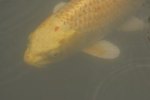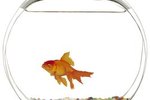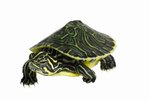
Koi are raised in closed environments where they are prone to fungus and disease. Fungus is most common in ponds with crowded populations, although koi are also susceptible to fungal infections during periods of high stress. Treatments are available -- ideally, you'll separate infected fish into a holding pond to prevent the spread of disease. Monitor your koi's appearance daily to catch infections early. Look for irregular white spots and growths to identify a fungal infection.
Quarantine Treatment
Remove the infected fish from the main population. Keep the fish in an isolated quarantine tank with the same water temperature as the main pond. Transferring fish into an area of similar temperature reduces stress during the transition phase. Keep the fish in quarantine for one week and allow it to fight the fungus naturally. Isolation and time are enough to beat fungal infections if the infection is caught early. Advanced infections will require medical treatments.
Salt Treatments
Small doses of salt are effective against fungus. Only use salt treatments in your quarantine area as the salt can kill water plants in the primary pond. Add a 1 percent salt solution to the quarantine tank for one week. If the fungus is not completely cured, increase the salt to 2 percent for a half hour. Return the fish to the primary tank following the salt bath. Monitor the fish for several days to ensure the fungus does not return.
Medical Treatment
If isolation and salt bathing do not cure the fungus, medication is required. Purchase medicated food designed for fungal treatment through your pet store or Internet outlet. Medicated food ensures the koi receives the medication internally. Also, net the infected fish and use a cotton swab to apply hydrogen peroxide against the infected areas. This will help kill and contain the fungus. Use a soft net and return the fish to the water quickly to prevent stress.
Preventing Fungus
Fungal infections are often the result of poor water management. Clean your pond regularly and replace old filters to ensure high water quality. Monitor your fish and remove infected individuals immediately. Do not overpopulate your pond as the stress leads to weakened immunities and increased chances of disease. Also, monitor the pH levels of the water and attempt to maintain a level of 7. Do not make drastic changes to the pH or the water temperature because intense change causes stress.
References
Photo Credits
-
Hemera Technologies/Photos.com/Getty Images
Writer Bio
Zach Lazzari is a Montana based freelance outdoor writer and photographer. You can follow his work at bustedoarlock.com.




